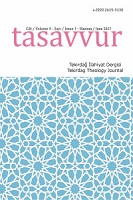Arap Belâgatinde Kinaye Tanımları ve Tasniflerindeki Farklılıkların Değerlendirilmesi: Modern Dönem Bağlamında
The Evaluation of Differences in Definitions and Classifications of Kināya in Arabic Rhetoric: In the Context of the Modern Period
Author(s): Ahmet GezekSubject(s): Social history, Rhetoric
Published by: Tekirdağ Namık Kemal Üniversitesi İlahiyat Fakültesi
Keywords: Arabic Rhetoric; Rhetoric Theory; Rhetoric Books; Classification; Kināya;
Summary/Abstract: In the dictionary, kināya, which means “to say a word and to mean a second meaning with that word”, means “to use a word both in its true meaning and in a second meaning other than this meaning“ as the Arabic rhetoric term. The conceptualization process of kināya as a sub-title of the ilm al-bayān started in the second century hijrī and took its present form in the seventh century hijrī with Abū Yaʿqūb al-Sakkākī (d. 626/1229) and in the eighth century with Khaṭīb al-Qazwīnī (d. 739/1338). The authors of modern Arabic rhetoric, based on the methodological approaches of these two authors in their definitions and classifications of kināya, sometimes adopted the same approach as they were, and sometimes made some additions and criticisms by making original evaluations. For example, Qazvinî's لفظ أريد به لازم معناه مع جواز إرادة معناه حينئذ “(Original) meaning can be meant, but the necessary meaning is the word that is meant by it.” While some contemporary authors have taken the definition of kināya with the same words, some have added the phenomenon of clue to this definition. There is a similar situation in the classification of kināya, and while some authors have taken the categorization made by Sakkākī without making any changes, some authors have made various additions to this division. In the modern period covering the last century, many books have been written on Arabic rhetoric, and some of these books have come to the fore in Arab countries and our country. In this study, in the context of the subject of kināya, twelve of the Arabic rhetoric books written in the modern period were selected and the definitions and classifications of kināya in these books were examined. The aim of this study is to bring together and compare various perspectives on kināya in contemporary Arabic rhetoric books and to identify different approaches to the subject.
Journal: Tasavvur Tekirdağ İlahiyat Dergisi
- Issue Year: 9/2023
- Issue No: 1
- Page Range: 433-457
- Page Count: 25
- Language: Turkish

